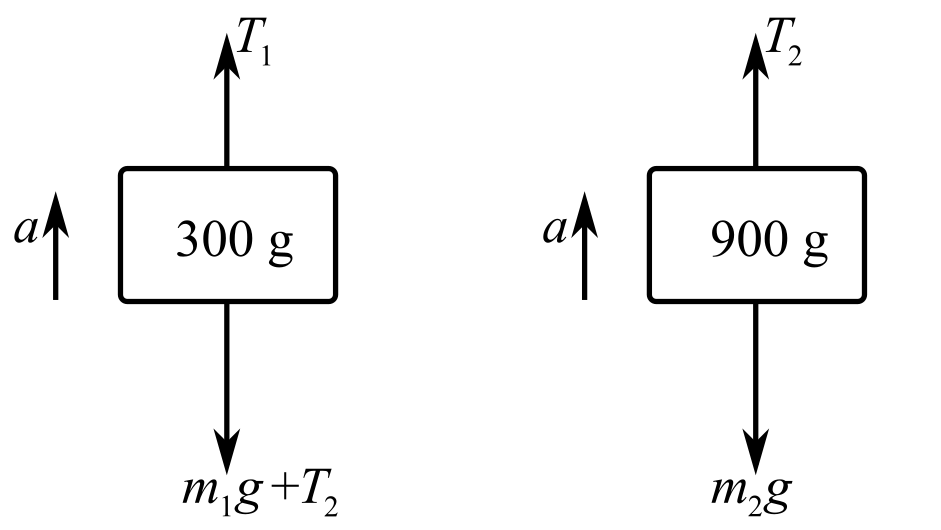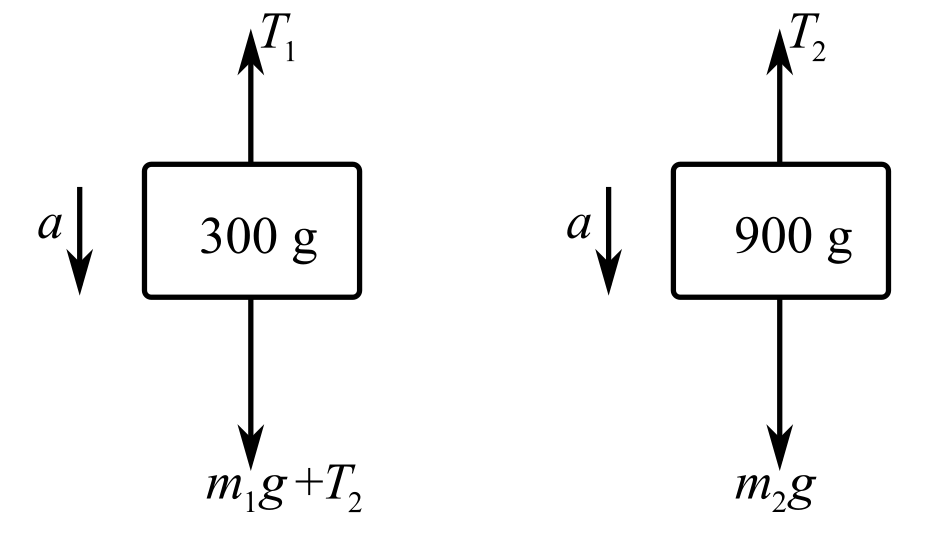
Concept explainers
A 300-g mass hangs at the end of a string. A second string hangs from the bottom of
that mass and supports a 900-g mass. (a) Find the tension in each string when the
masses are accelerating upward at
tension in each string when the acceleration is
(a)
The tension in eachstring when the masses are accelerating in upward direction at
Answer to Problem 64SP
Solution:
Explanation of Solution
Given data:
The mass of the block that is hanging on the first string is
The mass of the block that is hanging on the second string is
Upward acceleration of the masses is
Formula used:
From the Newton’s second law of the motion, the expression of the force is
Here,
Explanation:
Draw the free body diagram of the system by analyzing the problem:

In the above diagram,
Draw the free body diagram of the masses separately when acceleration is in upward direction:

Consider free body diagram of the
Consider the direction of the upward forces as positive and the direction of the downward forces as negative. Therefore,
Here,
Substitute
Solve the above equation for
Consider free body diagram of the
Consider the direction of the upward forces is positive and the direction of the downward forces is negative. Therefore,
Substitute
Solve the above equation for
Conclusion:
Therefore, the value of the tension in the strings by which
(b)
The tension in each string when the masses are accelerating in the downward direction at
Answer to Problem 64SP
Solution:
Explanation of Solution
Given data:
The mass of the block that is hanging on the first string is
The mass of the block that is hangingon the second string is
Downward acceleration of the masses is
Formula used:
From the Newton’s second law of the motion, the expression of the force is
Here,
Explanation:
Draw the free body diagram of the each masses separately when acceleration is in downward direction:

Consider the free body diagram of the
Consider the direction of the upward forces as positive and the direction of the downward forces as negative. Therefore,
Substitute
Solve the above equation for
Consider the free body diagram of the
Consider the direction of the upward forces is positive and the direction of the downward forces is negative. Therefore,
Substitute
Solve the above equation for
Conclusion:
Therefore, the value of the tension in the strings by which the
Want to see more full solutions like this?
Chapter 3 Solutions
Schaum's Outline of College Physics, Twelfth Edition (Schaum's Outlines)
- A black widow spider hangs motionless from a web that extends vertically from the ceiling above. If the spider has a mass of 1.5 g, what is the tension in the web?arrow_forwardA car is stuck in the mud. A tow truck pulls on the car with the arrangement shown in Fig. P4.32. The tow cable is under a tension of 2 500 N and pulls downward and to the left on the pin at its upper end. The light pin is held in equilibrium by forces exerted by the two bars A and B. Each bar is a strut; that is, each is a bar whose weight is small compared to the forces it exerts and which exerts forces only through hinge pins at its ends. Each strut exerts a force directed parallel to its length. Determine the force of tension or compression in each strut. Proceed as follows. Make a guess as to which way (pushing or pulling) each force acts on the top pin. Draw a free-body diagram of the pin. Use the condition for equilibrium of the pin to translate the free-body diagram into equations. From the equations calculate the forces exerted by struts A and B. If you obtain a positive answer, you correctly guessed the direction of the force. A negative answer means that the direction should be reversed, but the absolute value correctly gives the magnitude of the force. If a strut pulls on a pin, it is in tension. If it pushes, the strut is in compression. Identify whether each strut is in tension or in compression.arrow_forwardDoes the ground need to exert a force on you for you to jump off the ground, or do you need to exert a force on the ground? If the ground must exert a force on you, is that force greater than the force you exert on the ground?arrow_forward
- Two masses are attached to a spring scale as shown in Fig. 3.25. If both masses are 1 kg, which force, in newtons, would the scale read? (Hint: Think of holding a free end of the rope on one side of the scale with only the weight on the other.) Figure 3.25 What Does the Scale Read? See Short Answer 16.arrow_forwardA 3.00-kg block starts from rest at the top of a 30.0 incline and slides a distance of 2.00 m down the incline in 1.50 s. Find (a) the magnitude of the acceleration of the block, (b) the coefficient of kinetic friction between block and plane, (c) the friction force acting on the block, and (d) the speed of the block after it has slid 2.00 m.arrow_forwardFor the woman being pulled forward on the toboggan in Figure 4.33, is the magnitude of the normal force exerted by the ground on the toboggan (a) equal to the total weight of the woman plus the toboggan, (b) greater than the total weight, (c) less than the total weight, or (d) possibly greater than or less than the total weight, depending on the size of the weight relative to the tension in the rope?arrow_forward
- A bag of cement whose weight is Fg hangs in equilibrium from three wires as shown in Figure P5.18. Two of the wires make angles 1 and 2 with the horizontal. Assuming the system is in equilibrium, show that the tension in the left-hand wire is T1=Fgcos2sin(1+2) Figure P5.18arrow_forwardCalculate the tension in a vertical strand of spider webif a spider of mass 8.00×10−5 kg hangs motionless on it.(b) Calculate the tension in a horizontal strand of spider web ifthe same spider sits motionless in the middle of it much likethe tightrope walker . The strand sags at anangle of 12º below the horizontal. Compare this with thetension in the vertical strand (find their ratio).arrow_forwardAn object weighing 4.5kg originally suspended by a vertical cord is pulled by a horizontal force until the cord makes and angle of 60˚ with the vertical. Find (a.) the tension in the cord, and the (b) the magnitude of the horizontal force to keep the object in this position.arrow_forward
- A locomotive is pulling 12 freight cars, each of which is loaded with the same amount of weight. The mass of each freight car (with its load) is 37,000 kg. If the train is accelerating at 0.78 m/s2 on a level track, what is the tension in the coupling between the second and third cars? (The car nearest the locomotive is counted as the first car, and friction is negligible.)arrow_forwardTo hang a 6.00 kg pot of flowers, two wires are used—one attached horizontally to a wall, the other sloping upward at an angle of 45degree and attached to the ceiling. Find the tension in each wire.arrow_forwardA worker pulls a 15-kg crate in a straight line on a level surface by imparting a horizontal tension of 80 N to the free end of a cable whose other end is attached to the crate. If the coefficient of static friction is 0.40, what is the acceleration of the crate?arrow_forward
 Physics for Scientists and Engineers: Foundations...PhysicsISBN:9781133939146Author:Katz, Debora M.Publisher:Cengage Learning
Physics for Scientists and Engineers: Foundations...PhysicsISBN:9781133939146Author:Katz, Debora M.Publisher:Cengage Learning Principles of Physics: A Calculus-Based TextPhysicsISBN:9781133104261Author:Raymond A. Serway, John W. JewettPublisher:Cengage Learning
Principles of Physics: A Calculus-Based TextPhysicsISBN:9781133104261Author:Raymond A. Serway, John W. JewettPublisher:Cengage Learning Glencoe Physics: Principles and Problems, Student...PhysicsISBN:9780078807213Author:Paul W. ZitzewitzPublisher:Glencoe/McGraw-Hill
Glencoe Physics: Principles and Problems, Student...PhysicsISBN:9780078807213Author:Paul W. ZitzewitzPublisher:Glencoe/McGraw-Hill Physics for Scientists and EngineersPhysicsISBN:9781337553278Author:Raymond A. Serway, John W. JewettPublisher:Cengage Learning
Physics for Scientists and EngineersPhysicsISBN:9781337553278Author:Raymond A. Serway, John W. JewettPublisher:Cengage Learning Physics for Scientists and Engineers with Modern ...PhysicsISBN:9781337553292Author:Raymond A. Serway, John W. JewettPublisher:Cengage Learning
Physics for Scientists and Engineers with Modern ...PhysicsISBN:9781337553292Author:Raymond A. Serway, John W. JewettPublisher:Cengage Learning An Introduction to Physical SciencePhysicsISBN:9781305079137Author:James Shipman, Jerry D. Wilson, Charles A. Higgins, Omar TorresPublisher:Cengage Learning
An Introduction to Physical SciencePhysicsISBN:9781305079137Author:James Shipman, Jerry D. Wilson, Charles A. Higgins, Omar TorresPublisher:Cengage Learning





